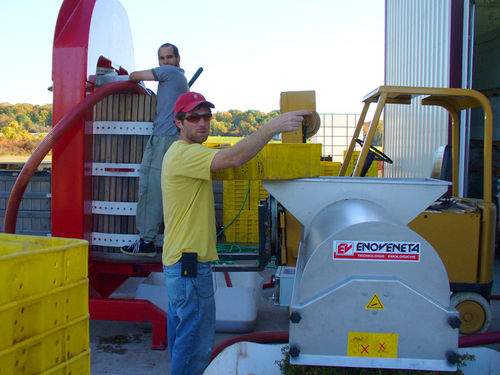Bryan working the harvest at Freedom Run Winery
By Bryan Calandrelli, Niagara Correspondent
This year, only a handful of growers and wineries were expecting anything close to a full crop from their young vines here in the Niagara Escarpment. Unfortunately, Mother Nature wasn’t kind to many of them.
With at least three hailstorms, relentless humidity and warm, soggy conditions, this was not the season to have your sprayer break down. Those that survived hail damage had to spray often to battle mildew and the not-so-noble sour rot. Ripening was slightly delayed with most varieties, but there’s one silver lining: if you did keep your grapes free of rot, a warm, dry period at the end of the season made it possible to reach the sugar levels needed for medium bodied wines with good flavors.
Duncan Ross of Arrowhead Spring Vineyards, whose vines are just starting to produce close to a full crop, shared some insight into his growing season:
“With a wet May, June and July, weeding was a priority, along with trimming to control the extra vigor that the warm wet weather had encouraged. Two hailstorms took their toll on the vineyard, but in retrospect it saved us from having to do a lot of cluster thinning at veraison. Our spray program had to be adjusted for the increased disease. In August, September and October, we had glorious warm sunshine and it was quite a bit drier.”
Freedom Run Winery is adjacent to Arrowhead Spring Vineyards, nestled on the bench of the Escarpment and its vines were planted the same season as their neighbors’. I worked in their vineyards and production facility this year, so I have some first-person insight into their growing season. They took in pinot noir for sparkling wineearly in the season as well as three separate pinot harvests from various sites on the estate in late September. They also brought in chardonnay, for what should be a naked version, as well as riesling grapes, which were given an arrested fermentation to keep a natural level of sweetness.
Pinot noir, riesling and chardonnay are more prone to rot in warm wet seasons, so there was a sense of relief after those came in. With the Bordeaux grapes hanging into late October, the concern turned to sugar levels and overall ripeness. But, that concern turned into enthusiasm when the merlot came in around 23 brix and the cabernet franc at 22 brix, with the cabernet sauvignon close behind.
After pressing, owner Larry Manning was encouraged by what he saw with his reds, and after 2 months of harvesting, I must say that I was surprised by the extraction and concentration of the young wines I helped harvest, crush and press.
In addition to these wineries, Spring Lake Winery took in its first full harvest of its pinot noir and riesling and they have plans for a late harvest bottling as well. Chateau Niagara in Newfane, NY brought in the first Gewurztraminer from our area along with riesling and a soon-to-be-naked chardonnay. As for me, I chipped in with fellow wine geeks to make a barrel of pinot noir with grapes from another new grower who also harvested pinot gris, riesling and a little sauvignon blanc.
The 2008 vintage will see the most estate wines produced ever in this region. While the weather wasn’t ideal, these young wineries seem to have met the challenge. With news reports of some Niagara, Ontario growers without buyers for their rot affected crop, it’s encouraging to see and taste the flourishing young wines from my backyard.

